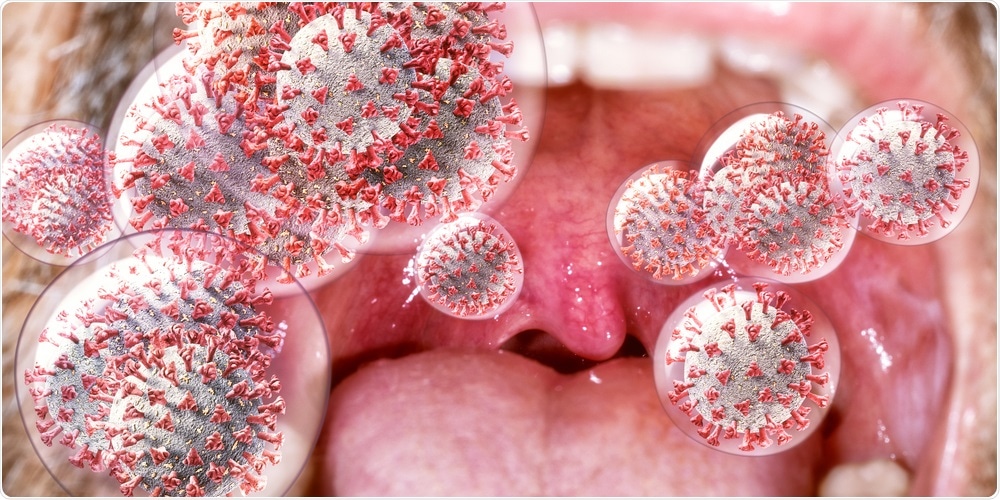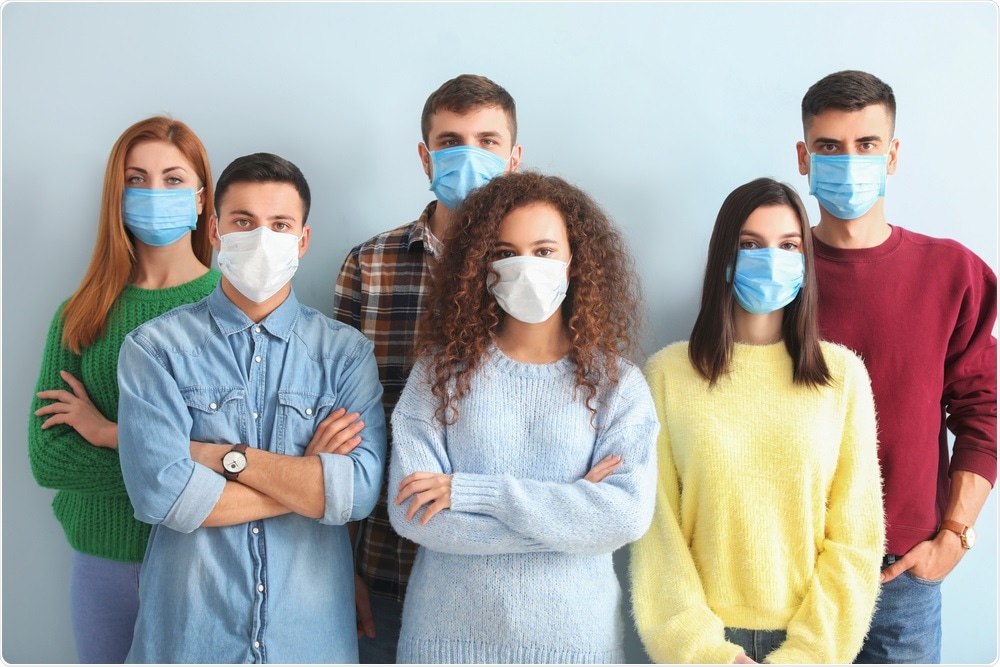 Thought LeadersDr. Keiko IshiiAssistant ProfessorAoyama Gakuin University
Thought LeadersDr. Keiko IshiiAssistant ProfessorAoyama Gakuin UniversityIn this interview, News-Medical speaks to Dr. Keiko Ishii about her research efforts during the COVID-19 pandemic and how speaking whilst infected can cause the virus to spread, and why wearing masks is so important.
What provoked your research efforts into the COVID-19 pandemic?
Our research started when Professor Onishi of Yamano College of Aesthetics in Japan asked me for an image that would help to prevent the spread of infections at a beauty salon.
It is natural to be careful about sneezing and coughing in people who have symptoms. However, it has been identified that coronavirus can also be asymptomatic and that these people can be infectious, which may cause explosive spread.
A beauty welfare researcher at Yamano College of Aesthetics said that we should be careful about aerosol infection during customer service to prevent the spread of infection. It is important to understand these phenomena and thoroughly take measures against infections. This can allow professionals to provide beauty and long-term care in order to prevent economic stagnation and maintain quality of life, whilst showing peace of mind to avoid social turmoil.
For infection control to be widely recognized and implemented, it is important to show it not only in the words of experts but also in easy-to-understand photographs and videos.
Since I usually specialize in visual measurement of flow and temperature in thermal engineering and fluid engineering research, I was asked for technical cooperation in acquiring the exhalation images. I had thought that it would only be biology and medical personnel who could contribute to solving the coronavirus problem, and so I was happy that despite specializing in engineering I could contribute to coronavirus infection control by participating in this project.
I had not studied breath flow before this. At first, my aim was just to take some pictures that gave the message, "If you do not wear a mask, you are more likely to get infected! Everyone should wear a mask!".
However, while shooting with various posture patterns with or without a mask and with or without a face shield, I noticed that the tendency of flow changes according to physical rules. When I examined past research, this had not been reported, and so I decided to summarize them as a treatise.

SARS-CoV-2 Virus. Image Credit: CROCOTHERY/Shutterstock.com
How is COVID-19 spread?
There are various routes to disease infection and the risk of aerosol infection has been discussed in recent years. Currently, there are no quantitative studies on the levels of aerosol exposure that can cause infection.
In the past, measures against infectious diseases, airborne infections and droplet infections have been mainly discussed. Measles is an example of a highly infectious virus that causes airborne infection, but it is understood that COVID-19 does not have enough infectivity to cause airborne infection. Here, it is important to understand the difference between airborne and aerosol infections.
Currently, there is no clear definition for aerosol infection. Most of the droplets from coughing and sneezing have a size of 5 μm or more and are heavy, so they disperse to about 1 to 2 m. These can be suppressed by wearing a mask. It is said that among the droplets emitted by coughing, sneezing, and speech, fine particles of 2 to 3 μm or less diffuse widely and float in the air for several hours.
Even in our experiment, particles of 1 µm or less floated in the air for a long time. Normally, minute aerosols dry quickly, and it is believed that the virus does not remain infectious for a long time in the dry state.
It has also been reported that the deposition rate in the nasal cavity and upper respiratory tract is relatively low compared to particles of 5 μm or larger. However, it has been pointed out that in a densely populated area, damp environment, or in a closed environment, the aerosol containing the virus may continue to float in the air for a long time while retaining moisture and infectivity.
Aerosol infections are beginning to be thought of as a major cause of the spread of the virus, as many infection clusters have been reported in dense and closed environments.
How do air droplets spread viruses and cause infection?
From the information currently available, we believe that inhaling a large amount of fresh aerosol that has just been exhaled by an infected person or exposing it to the mucous membrane will increase the probability of infection.
As mentioned above, close proximity in a closed, humid environment will keep the virus active and more likely to cause infection. It is easy to forget because the particles and the air are invisible, but even with speech and breathing, the airflow changes drastically. If you communicate with each other without a mask in a short distance, you will always inhale the freshly exhaled aerosol.
In this study, even if you just mumbled such as you might in a business situation, the aerosol diffused 50 cm in a few seconds without a mask. I think that the risk is higher if you talk with a friend where you may be talking louder or laughing out loud.
Without a mask, the exhaled breath moves toward the front of the body due to the inertia force and diffuses randomly. If you wear a mask, the aerosol stays on the surface of your body and rises due to the heat of the body, preventing the aerosol from hitting people around you directly.
It is thought that once the aerosol has risen, it will continue to float and then come down; however, since the traveling distance will be longer, theoretically the water will evaporate during this period and the infectivity will decrease.
Masks are useful when facing each other at similar face heights to prevent contact with the fresh breath of another person. Furthermore, when you wear a mask, the aerosol rises from the top of your head. It flows between the scalp and the hair and is released from the top of the head. The scalp of an infected person wearing a mask is a warm and moist environment, and the exhaled breath containing the virus is constantly passing through.
It is better not to touch your mouth or eyes, pick your nose, or grab a sandwich and eat after touching the scalp or hair of another person without washing your hands. This is not just limited to beauticians and caregivers. We often get careless.
Can you describe how you carried out your latest research into COVID-19 and speaking and what you discovered?
I was able to carry out this experiment because of the professors at the Yamano College of Aesthetics and their enthusiasm for social contribution, and the interdisciplinary research organization of the Aoyama Gakuin University which induced me with a sense of responsibility.
Fortunately, the particle size of the exhaled aerosol and the particle size of an electronic cigarette was similar. The viral aerosol particles are problematic for infection, so we decided to use the electronic cigarette for the tracer particles. The liquid of the electronic cigarette was nicotine-free, and we took steps to make sure it was a healthy experiment for participants. A 3W laser sheet was irradiated and we photographed the scattered light of the smoke of the electronic cigarette with a camera.
The experimental system was very simple and is common in fluid experiments. However, in general, airflow experiments commonly use oil mist or dust for the tracer, which is not suitable for human experimentation. To avoid health hazards, we decided to use electronic cigarettes.
We adopted this method with the advice of Mr. Mikami of Kato Koken co. Ltd, a company specializing in optical measurement systems. All of our staff were non-smokers, and so it was hard at first. The exhaled breath behaved differently than originally expected, which was curious. When I summarized it according to the postural conditions, it became clear that the breath was moving according to the thermohydrodynamic mechanism.

Aerosol Transmission of SARS-CoV-2. Image Credit: Ingo Bartussek/Shutterstock.com
What role do masks and face shields play in preventing the spread of COVID-19?
It is well known that large droplets fly forward without a mask. It is important to wear a non-woven mask, as both exhaled aerosols and large droplets will not fly forward if you wear a non-woven mask. In contrast, urethane masks (which are popular in east Asia) and cloth masks can suppress large droplets, but allow exhaled aerosols to pass through.
By wearing a mask, the expiratory aerosol that has stagnated on the surface of the body slowly rises along the surface of the body due to the warmth of the body. This eliminates the exhaled aerosol that has just come out of the mouth directly hitting others.
Shortly after the pandemic began, it was widely recognized in Japan that face shields alone were meaningless. The face shield alone cannot effectively block droplets and aerosols. What was discovered in this study is that when facing down, the exhaled aerosol leaking from the upper and lower ends of the mask, even with the mask, is disturbed and heads downward.
Here, it was found that when the face shield and mask were worn, the exhaled aerosol became more likely to stay on the surface of the body, and the warmed aerosol did not go down. In other words, when a caregiver, a medical professional, a cosmetologist, or a masseuse approaches a person underneath, it is thought that the exposure dose of exhaled aerosol can be effectively reduced by wearing both a mask and a face shield.
What advice would you give to people that are visiting services such as hair salons and medical rooms?
I think it is a good idea to have a doctor or beautician always wear a non-woven mask. As mentioned above, the exhaled breath of a person who faces downwards tends to move downwards while being disturbed, even when wearing a mask.
For this reason, when lying down and undergoing treatment, there is a high possibility that the practitioner's exhaled aerosol, approaching from above, will hit the customer’s body. If you wear both a mask and a face shield, the exhaled aerosol will move upward along the service operator's body, preventing it from traveling to the customer below.
When facing upwards, the expiratory aerosol tends to diffuse upwards in a turbulent manner, even with a mask or face shield. This makes it difficult for practitioners approaching from above to avoid exhaled exposure. I feel that many jobs with a high risk of COVID-19 infection tend to be the type in which customers lie down and receive services, but I think that this is also related to the flow characteristics of exhaled breath.
When lying down, instead of being completely horizontal, if you wear a mask and lie with an inclined backrest, the exhaled breath tends to rise straight from the forehead. If the customer lies down with the backrest tilted to some extent and the practitioner understands that the updraft of exhaled air is generated from the customers' forehead, the practitioner will not be exposed to the exhaled breath directly.
At a beauty salon, the mask is an obstacle for customers when shampooing or cutting. With the mask on, exhaled breath rises from the crown. Without a mask, the exhaled breath tends to stagnate in front of the customer. In either case, the exhalation is not positively directed toward the practitioner who is behind or to the side, so I think that the presence or absence of the mask of the sitting customer does not affect the infection to the practitioner to that extent.
Do you believe that with further understanding of COVID-19, we can help to reduce its spread?
When the spread of COVID-19 began in 2020, it was said that the rate of spread of infection was slower in East Asian countries such as Japan than in Europe and the United States. I think there are various causes for this.
One of the factors is that East Asia is a culture with little skinship, is accustomed to wearing masks, and shampoo their hair a lot. I think that this cultural human behavior was related to the spread of infection.
From the results of this study, I feel that reducing skinship, wearing a mask, and shampooing are important actions to reduce the risk of infection. I think that it is possible to reduce the spread of infection by understanding when the risk of infection is high and changing our lifestyles.
The video I took was featured on Twitter and so on. There was a surprisingly large response, and I saw many responses fearful of exhalation. It is dangerous to be too scared, but I feel that this is one way to raise awareness of the danger of infection in society, visualizing what is invisible.

People wearing Masks. Image Credit: Pixel-Shot/Shutterstock.com
What are the next steps in your research?
Originally, I was not specialized in exhaled breath flow, but I think it would be interesting to examine the effects of movement of the human body, differences in the surrounding environment, and interference between the exhaled breaths of two people.
Since the quantitative study of aerosol infection has not been conducted, it may be useful to verify how much labeled aerosols settle in the nasal cavity and lungs of mammals. I would like to continue doing a lot of research without being bound by the field.
Where can readers find more information?
The article can be found here: “Relationship between human exhalation diffusion and posture in a face-to-face scenario with utterance”. Physics of Fluids. https://aip.scitation.org/doi/10.1063/5.0038380
About Dr. Keiko Ishii
Keiko Ishii, Ph. D., is an assistant professor working at the Department of Mechanical Engineering, Aoyama Gakuin University in Japan. She conducts a wide range of research in engineering and medical engineering using thermal fluid visualization and measurement technology.
As a Ph.D. student at the University of Tokyo, Keiko generated the non-invasive mixing method that can be used for the Lab-on-a-chip system and received a fellowship from the Japan Society for the Promotion of Science.
Posted in: Thought Leaders | Medical Science News | Medical Research News | Disease/Infection News | Healthcare News
Tags: Breathing, Cigarette, Coronavirus, Coronavirus Disease COVID-19, Coughing, Doctor, Electronic Cigarette, Hair, heat, Infection Control, Infectious Diseases, Lab-on-a-Chip, Lungs, Measles, Nicotine, Pandemic, Particle Size, pH, Posture, Research, Respiratory, Sneezing, Speech, Virus

Written by
Emily Henderson
Emily Henderson graduated with a 2:1 in Forensic Science from Keele University and then completed a PGCE in Chemistry. Emily particularly enjoyed discovering new ideas and theories surrounding the human body and decomposition.In her spare time, Emily enjoys watching crime documentaries and reading books. She also loves the outdoors, enjoying long walks and discovering new places.Emily aims to travel and see more of the world, gaining new experiences and trying new cultures. She has always wanted to visit Australia and Indonesia.
Source: Read Full Article
